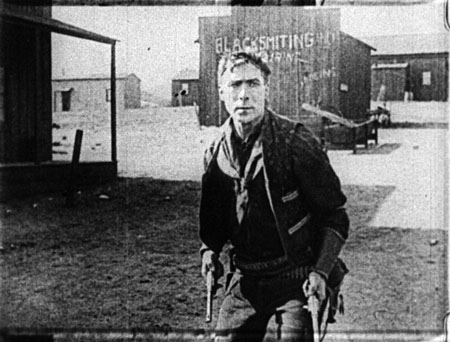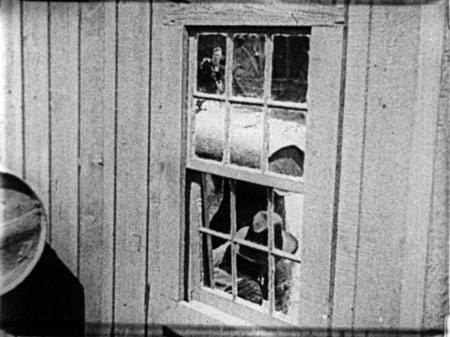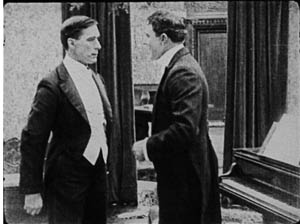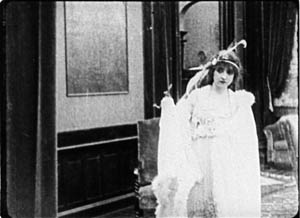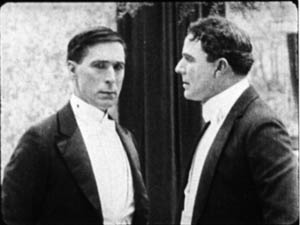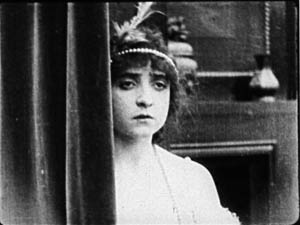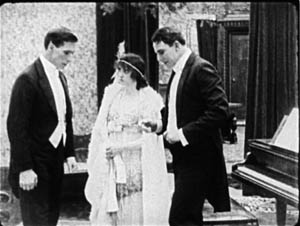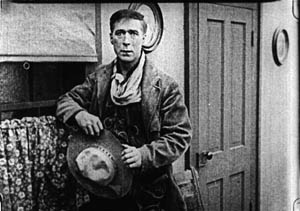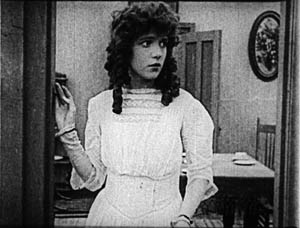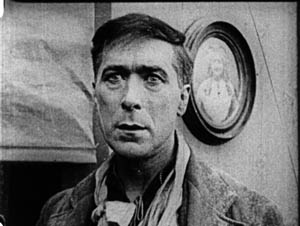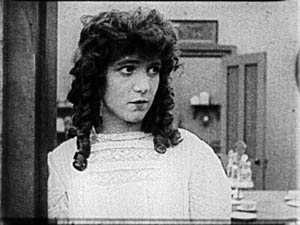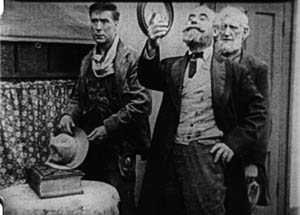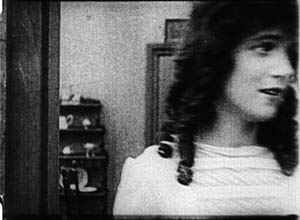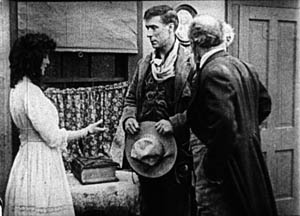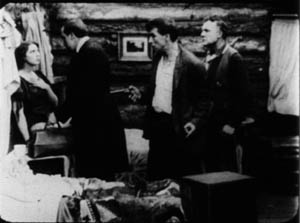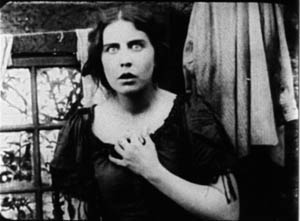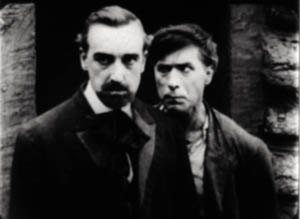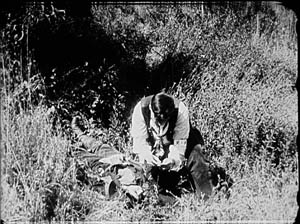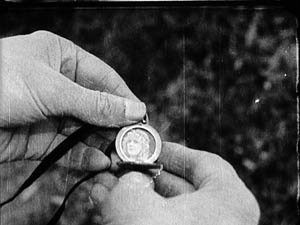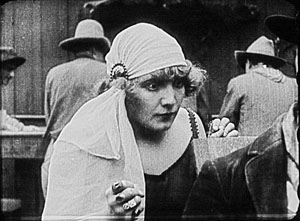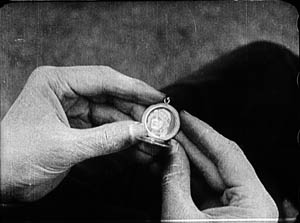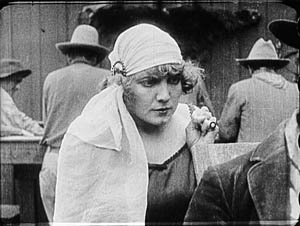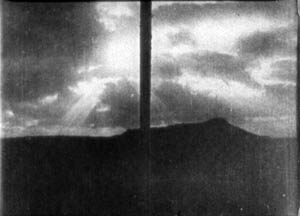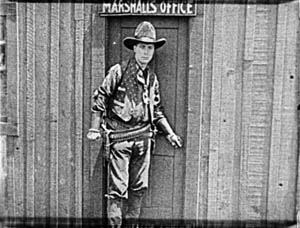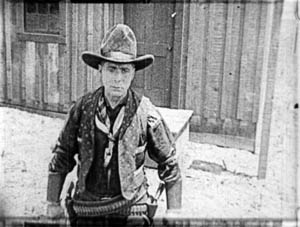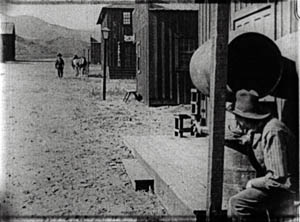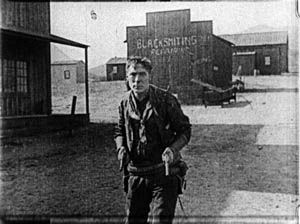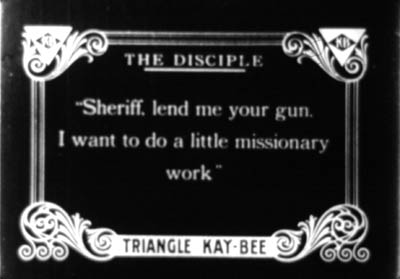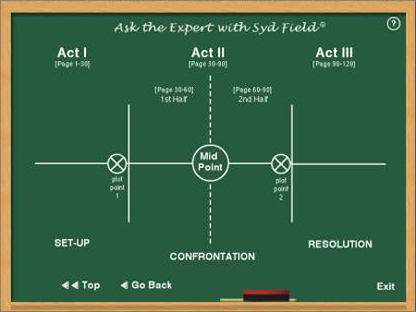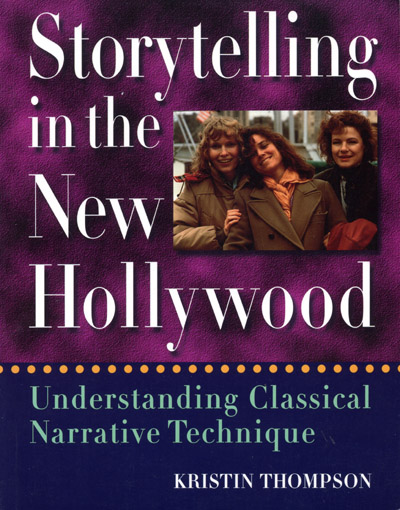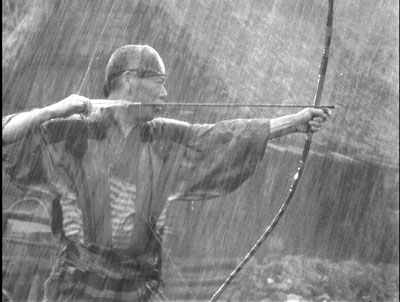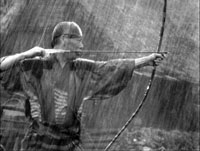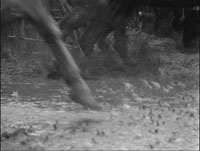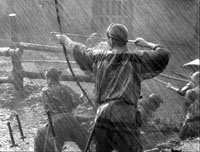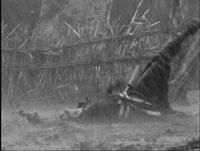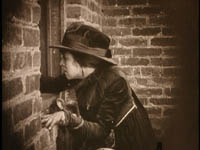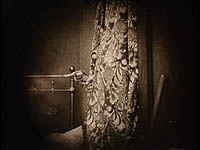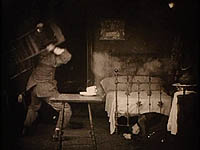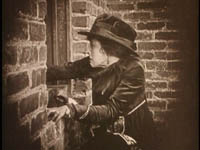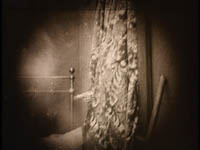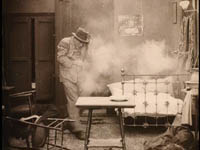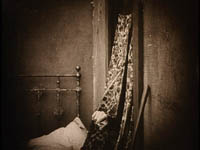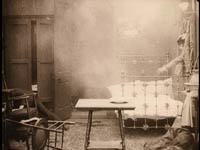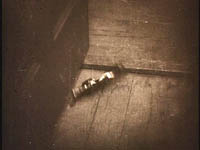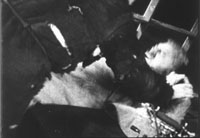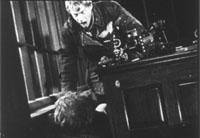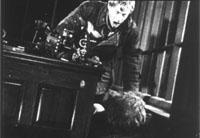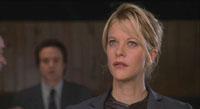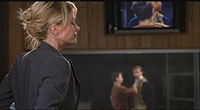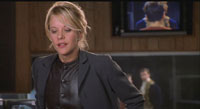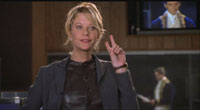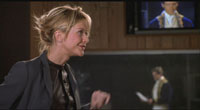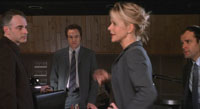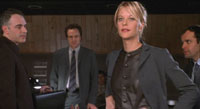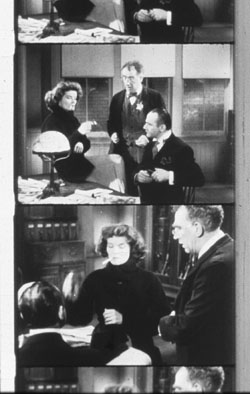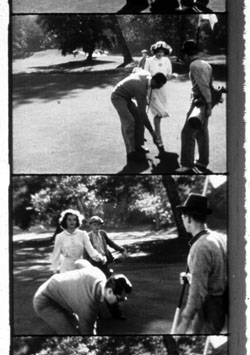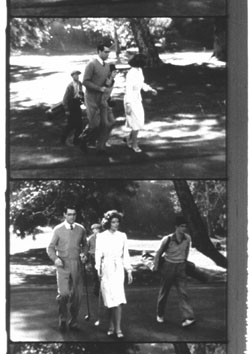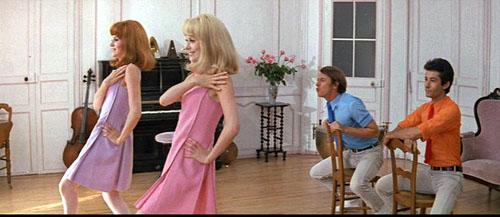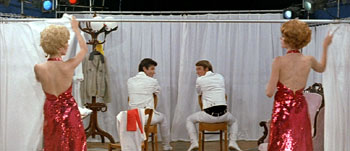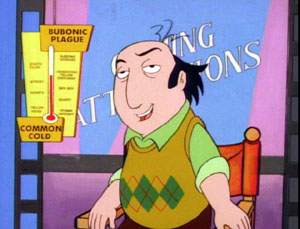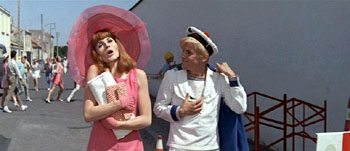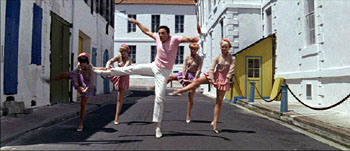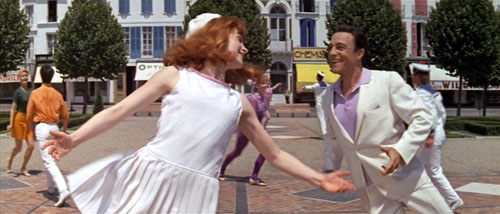Archive for the 'FILM ART (the book)' Category
Rio Jim, in discrete fragments
The first moving-pictures, as I remember them thirty years ago, presented more or less continuous scenes. They were played like ordinary plays, and so one could follow them lazily and at ease. But the modern movie is no such organic whole; it is simply a maddening chaos of discrete fragments. The average scene, if the two shows I attempted were typical, cannot run for more than six or seven seconds. Many are far shorter, and very few are appreciably longer. The result is confusion horribly confounded. How can one work up any rational interest in a fable that changes its locale and its characters ten times a minute?
H. L. Mencken, 1927
DB here:
Between about 1913 and 1920, the way movies looked changed, and we are still living with the results. What were the changes? What brought them about?
I’m just back from Brussels, after a two-week visit to the archive. During earlier trips, I’ve concentrated on examining films from the 1910s that exemplify the tableau tradition. That’s what we might call the stylistic approach that tells the story and achieves its other effects predominantly through staging—by arranging the actors within the frame, forming patterns that reflect what is important at a given moment.
The tableau tradition dominated European cinema of the early and mid-1910s, and it was also on display in the U. S. It is sometimes considered “theatrical” and “uncinematic,” but that’s a shortsighted view. The tableau tradition is one of the great artistic triumphs of film history. For backup on this, consult Ben Brewster and Lea Jacobs’ Theatre to Cinema and my On the History of Film Style and Figures Traced in Light. And you can go here and here on this site.
As the 1910s moved on, the staging-driven approach gave way to one dominated by editing. Roughly speaking, this strategy surfaced at two levels. Directors began to use crosscutting, aka parallel editing, more strenuously. By alternating shots, you could show events taking place at two or more locations. This technique was not used only for last-minute rescues; it was a way of keeping track of all the characters in nearly every sequence, whether they were going to converge or not.
Second, within a single strand of action, 1910s directors exploited analytical editing, breaking down a scene’s space into a host of details. Griffith often gets the credit for this tactic (and he happily claimed to have invented it), but it’s probably most fairly understood as a collective innovation.
Directors in the tableau tradition didn’t entirely avoid crosscutting or analytical editing, but there was a measurable shift of gravity in the second half of the 1910s. In the U.S., many filmmakers pushed editing techniques very hard. You can sense their exhilaration in discovering how editing lets them control pacing, make story points concisely, build suspense, and force the viewer to keep up.
During the 1910s, American movies became breathless. The hurtling pace of Speed Racer or The Dark Knight has its origins here; seen today, The Battle at Elderbush Gulch (1913) and Wild and Woolly (1917) still look mighty rapid-fire. And then as now some observers, like Mencken, complained that it was all too fast and furious.
Over the last thirty years, many scholars have studied this change, but for a glimpse of some supporting data, you can visit the remarkable website Cinemetrics. Yuri Tsivian, Barry Salt, and a corps of volunteer scholars have been measuring Average Shot Lengths in films from all eras. The data from the 1910s are pretty unequivocal. In the US around 1916-1918, movies became editing-dominated, shifting from an ASL of over 10 seconds, sometimes as much as 30 seconds, to 5-6 seconds or less. A 4-6 second average per shot persists in Hollywood through the 1920s, so Mencken’s guess about the “scenes” (as shots were then known) changing ten times a minute was more or less right.
Back in the 1980s, Salt and others, including Kristin and me, picked 1917 as a plausible point of reference for the consolidation of the continuity style. That was the point at which virtually every US film we watched contained at least one example of specific continuity techniques. (Most contained many more instances, of course.) We talk about that magical year in this entry, which you might want to read as an introduction to what follows today.
In just a few years, continuity editing became a coherent, supple means of expression, and it has defined Hollywood film style up to the present. What brought this about? Kristin and Janet Staiger offered an explanation in our 1985 book, The Classical Hollywood Cinema: Film Style and Mode of Production to 1960. They traced out several factors that encouraged and sustained this style. Especially important were the development of longer films, a conception of filmic quality, and the emergence of a specific division of labor.
Lately I’ve been revisiting these early years, chiefly to watch how directors pick up and refine the stylistic schemas that were coming into broader use. I want to know more about the little touches that directors had to control in creating this style. I’ve also been interested in to what extent these techniques were picked up by directors in Europe and Asia. The evidence is pretty clear that continuity cinema became a lingua franca of film style.
So if last year I pondered the minute compositional adjustments of Evgenii Bauer, this year it was all cutting. I focused on three filmmakers, but I’ll save discussion of two of them for a rainy day, or a book. In all, it was a thrill, as ever, to watch a stylistic system coalesce across a batch of films that are seldom mentioned in the history books.
The trail to continuity
The extraordinary films starring William S. Hart typify early American continuity techniques. After a distinguished career on the stage, Hart began as a film actor in 1914, when he was nearly fifty. He was intent on bringing realism to the newly burgeoning Western genre. His films were at first made under the auspices of Thomas Ince, a pioneer of rationalized production techniques, and with his Ince pictures Hart found worldwide success. He followed a rousing feature debut (On the Night Stage, 1915) with many shorter films. In 1917—mark the year—Hart broke with Ince and set up his own firm for The Narrow Trail. He continued to make films into the early 1920s, with Tumbleweeds (1925) marking his farewell to cinema.
Hart often directed his own pictures, though he also had the services of strong directors like Reginald Barker. The films have an assured brio, thanks to careful cutting and some felicitous touches.
They are fast-moving: In the five 1915 Hart films I watched, the ASL ranged from 8 to 11 seconds, but in 1916, the average jumped to 5-6 seconds per shot. The Narrow Trail seems to have an ASL of 3.7 seconds, but I can hardly believe it and I must verify it with another viewing. The 1918 and 1920 films I viewed average between 4.9 and 5.4 seconds per shot.
Just as important as the speed of cutting, naturally, is what Hart does with his cuts. In one scene from Between Men (1916), you can see the tableau aesthetic undermined by analytical editing. Gregg is a shifty stock trader, a species we still nurture. He’s trying to destroy Hampton’s fortune because he thinks that when the old man is destitute he’ll force his daughter to marry Gregg. Hampton has asked Bob White (Hart) to help get the goods on the suitor.
In one scene, the master shot approximates a tableau setup: Bob and Gregg stand in the middle ground, with a room visible behind them.
As the men swap increasingly tense challenges, Margaret Hampton enters the adjacent room and stands behind them as they talk. A director in the tableau tradition would have sustained the master shot and shown Margaret approaching in the background and drawing closer, reacting to what the men say. She could easily have been stationed hovering at the curtain on the right.
Instead, director C. Gardiner Sullivan has her arrive from another doorway in the adjacent room, one not visible in the master shot of the two men. He then cuts back and forth between the men and Margaret, and he positions her at the left curtain–so that the men block her from our view! The blockage motivates cutting to Margaret for her reactions to what Bob and Gregg say.
Only when she wants to challenge Bob’s suggestion that he might marry her does Margaret come into the same frame as the men, who part to make room for her.
It turns out that this sequence is but a rehearsal for a lengthier passage in which Hampton will come in from the adjacent room (via the door we do see in the background). As with Margaret’s entrance, his arrival will be blocked by Gregg’s body, and Sullivan will cut among the trio in the foreground and Hampton’s approach behind them. That passage, which could also have been handled in a single framing in the tableau style, consists of four distinct setups and eighteen shots!
So even depth-based scenes can be recast as rapid découpage. The passage is probably overcut, but you can sense the filmmakers’ exhilaration in their power to chop up the world into separate, slightly jolting bits, forcing the audience to keep abreast of each item of information.
Managing details
The variety of setups is worth noticing in another film, for here we can see the filmmakers taking pains to show each bit of action most clearly and emphatically. In The Return of Draw Egan (1916), when Egan sees the mayor’s daughter Myrtle he decides to stay on as marshal of Yellow Dog. The first shots show them looking at each other.
The next pair of shots shows the two looking at each other in close-up.
This gradual enlargement of the figures in a reverse-shot sequence would of course become a staple of analytical editing—perhaps it already was in 1916. Cut back to another framing of Egan, as the mayor signals Myrtle to join them. The slightly off-center composition reiterates her position off left.
Cut back to Myrtle, exiting her close-up. The next shot shows her joining the men, to be introduced to Egan.
But this is a different camera position than the one showing the men just previously. The daughter’s entrance has motivated a slightly changed composition. In the 1910s, cutting began to dictate staging, so that each composition had to fit smoothly into the flow of shots.
This sequence from Draw Egan doesn’t utilize axial cuts, those cuts that keep to the same angle and move straight in or out. Here the actors are angled to suggest that we are to some degree in between them. Indeed, sometimes the camera will put us directly between the characters. Here is a climactic confrontation from The Disciple (1915). A doctor has cuckolded Hart, but Hart brings him to save his daughter. As the doctor enters, the wife’s shameful look is met by Doc’s anxious expression, with a furious Hart pressing a pistol to his back.
This freedom of camera placement extends to point-of-view cutting. Again, this is an old technique, but like other old techniques, it was revived and refined as part of the synthesis that became the continuity style. So Keno Bates, Liar (1915; a splendid title) can make use of a cameo picture that captivates Bates after a shootout with the man who robbed him.
Later, the dance-hall girl catches sight of her rival when Bates muses on the cameo.
The pov framings don’t change much, but the angle chosen easily approximates both Bates’ view and her view over his shoulder. Moreover, the shot of Bates’ hands isn’t the sort of vacuous insert we often see at the period, with a letter or an object isolated against a blank ground. Here, the backgrounds change, so that the first shot is situated naturally in the wild, while the second is consistent with the barroom locale.
Putting the pieces together
From very early in the history of Westerns, the main street shootout seems to have been a solid convention. Already in The Return of Draw Egan, it’s treated with a vitality and ingenuity that suggests creative reworking of a staple. The climactic shootout also shows just how flexible the new technique could be.
Egan has told his enemy, Arizona Joe, that he’ll meet him when the setting sun’s rays hit the saloon window. So the film crosscuts Egan in his marshal’s office with a nervous Joe, seen in close-up, eyeing the window.
When Joe gets up the nerve to leave, he hides behind a barrel and waits to ambush Egan. When Egan leaves his office, a reverse tracking shot follows him striding toward us.
Then we get an orienting long shot with Joe in the foreground and Egan approaching.
Edging sideways, Egan spots a reflection of Joe’s head in a window. These shots surmount today’s blog entry. You can see Egan’s reflection in the upper left pane.
Now aware of Joe’s tactic, Egan steps diagonally forward, coming ominously right up to the camera.
He fires and dispatches Joe. The townsfolk, who have been huddled in a house watching, declare they want Egan to stay on as marshal, despite his outlaw past. Myrtle chimes in, and we get a happy ending. Chaotic fragments? Mencken couldn’t have been more wrong. Or maybe he was just being grumpy.
The trail to Hollywood
There’s plenty more in these films—beautiful, sometimes minuscule matches on action; subtle timing of frame entrances and exits; and even proto-over-the-shoulder reverse shots. And we don’t have to claim that Hart’s films are the only innovative ones. They take their place within a broader, collective achievement that we still haven’t fully grasped.
Editing permitted everyone to act at small scale; the bargirl who sees Bates’ cameo need only lower one fist, tighten the other, and narrow her eyes to express her jealousy. The new style nurtured laconic stars like Hart. His films are full of pathetic situations that demand he display stoicism but also sensitivity. The long shots could emphasize his gestures and stances, while close-ups could display his worn, haunted face and pale eyes. He acts with those eyes, glancing aside to recall a traumatic event or looking downward as he hesitates to break bad news. Often the plot demands that he conceal his feelings or hide the truth behind an event, and the changing shots could penetrate the surface drama and highlight his slightest reactions. Hart could underplay his role because the editing shows us everything he might have said.
Known in France as Rio Jim, Hart was very influential on the Europeans. His pictures, along with De Mille’s The Cheat (1915) and the films of Chaplin and Fairbanks and many others, offered tutorials in the new style. Arguably, the cumulative force of these mainstream releases was greater than the influence of Griffith’s more prestigious output of the moment. There was only one Intolerance (1916), the film by which Griffith was most widely known abroad, but week by week the Westerns and comedies and dramas pouring out of Hollywood flaunted a new, almost frighteningly energetic approach to cinema.
Timing favored the Americans. The style emerged at around the start of World War I, when hostilities gave U. S. films a chance to displace the big French and Danish companies in many markets. Kristin explains how this happened in Exporting Entertainment, and she talks about the exceptional case of Germany in Herr Lubitsch Goes to Hollywood.
Some European directors picked up the new style immediately, others took a bit longer, and a few, like Feuillade, never fully adjusted to it. The principles of the older tableau style never utterly died out, as I try to show in Figures Traced in Light. But the future belonged to the editing-based aesthetic. Canonized, tweaked, updated, dismantled, undermined—however filmmakers reacted to classical continuity, it became the basis of international cinematic storytelling.
My epigraph comes from H. L. Mencken, “Appendix from Moronia: Note on Technic,” from Prejudices: Sixth Series (New York: Alfred A. Knopf, 1927), rep. in Phillip Lopate, ed., American Movie Critics: An Anthology From the Silents Until Now, expanded edition (New York: The Library of America, 2006), 35-36.
Silent film speeds can vary, so shot counts can yield different averages. I saw some of the Harts I mention in projection at last year’s Il Cinema Ritrovato, and they were projected at 18 or 19 frames per second, a common speed for the period. My ASLs are based on the running time. For the titles I saw in Brussels on a flatbed viewer, my basis was the length in meters. From that I’ve calculated running times and averages, assuming 18 frames per second. Projectionists of the time had freedom to screen at different speeds, so it’s possible that late 1910s Hart films were sometimes shown at 20 frames per second, which of course would make their cutting pace even faster.
For more on Hart’s career, see Diane Kaiser Koszarski, The Complete Films of William S. Hart: A Pictorial Record (New York: Dover, 1980). Koszarski devotes space to each film, with credits, excerpts from contemporary reviews, and excellent production stills. She also provides a sensitive critical overview. In William S. Hart: Projecting the American West (Norman: University of Oklahoma Press, 2003) Ronald L. Davis has given us a brief, engrossing biography based on interviews and extensive archival research. Hart’s memoir, My Life East and West (1929, reprint 1994) is of course indispensable.
Times go by turns
Kristin here—
Last week during the Society for Cognitive Studies of the Moving Image conference here in Madison, I got to talking with Prof. Birger Langkjær of the University of Copenhagen. He asked me some questions about the concept of “turning points” in film narrative as I had used it in my book, Storytelling in the New Hollywood: Understanding Classical Narrative Technique. Specifically he wondered if turning points invariably involve changes of which the protagonist or protagonists are aware. The protagonist’s goals are usually what shape the plot, so can one have a turning point without him or her knowing about it?
I couldn’t really give a definitive answer on the spot, partly because it’s a complex subject and partly because I finished the book a decade ago (for publication in 1999). It seemed worth going back and trying to categorize the turning points in films I analyzed. Describing those turning points more specifically could be useful in itself, and it might help determine to what extent a protagonist’s knowledge of what causes those turning points typically forms a crucial component of them.
Characteristics of turning points
Most screenplay manuals treat turning points as the major events or changes that mark the end of an “act” of a movie. Syd Field, perhaps the most influential of all how-to manual authors, declared that all films, not just classical ones, have three acts. In a two-hour film, the first act will be about 30 minutes long, the second 60 minutes, and the third 30 minutes. The illustration at the top shows a graphic depiction of his model, which includes a midpoint, though Field doesn’t consider that midpoint to be a turning point.
I argued against this model in Storytelling, suggesting that upon analysis, most Hollywood films in fact have four large-scale parts of roughly equal length. The “three-act structure” has become so ingrained in thinking about film narratives that my claim is somewhat controversial. What has been overlooked is that I’m not claiming that all films have four acts. Rather, my claim is that in classical films large-scale parts tend to fall within the same average length range, roughly 25 to 35 minutes. If a film is two and a half hours rather than two hours, it will tend to have five parts, if three hours long, then six, and so on. And it’s not that I think films must have this structure. From observation, I think they usually do. Apparently filmmakers figured out early on, back in the mid-1910s when features were becoming standard, that the action should optimally run for at most about half an hour without some really major change occurring.
Field originally called these changes “plot points,” and he defined them as “an incident, or event, that hooks into the story and spins it around into another direction.” Perhaps because of that shift in direction, these moments have come more commonly to be called “turning points.” But what are they? Field’s definition is pretty vague.
In Storytelling I wrote, “I am assuming that the turning points almost invariably relate to the characters’ goals. A turning point may occur when a protagonist’s goal jells and he or she articulates it .… Or a turning point may come when one goal is achieved and another replaces it.” I also assumed that a major new premise often leads to a goal change (p. 29). “Almost invariably” because I don’t assume that there are hard and fast rules. As with large-scale parts, my claims about other classical narrative guidelines aren’t prescriptive in the way that screenplay manuals usually are.
To reiterate a few other things I said about turning points. They are not always the same as the moments of highest drama. Using Jaws as my example, I suggest that the moments of decision (not to hire Quint to kill the shark and later to hire him after all), rather than the big action scenes of the shark attacks, shape the causal chain (p. 33).
Not all turning points come exactly at the end of a large-scale part of the film (an “act” in most screenplay manuals). A turning point might come shortly before the end of a part, or the turning point may come at the beginning of the new part (pp. 29-30). The final turning point that leads into the climax comes when “all the premises regarding the goals and the lines of action have been introduced” (p. 29).
Most screenplay manuals consider goals to be static. To me, “Shifting or evolving goals are in fact the norm, at least in well-executed classical films” (p. 52). This doesn’t mean that the goal changes at every turning point. Instead, the end of a large-scale part may lead to a continuation of the goal(s) but with a distinct change of tactics (p. 28).
One big advantage of talking about different types of turning points is that it allows the analyst to see how the different large-scale parts function. A well-done classical film doesn’t just have exposition and a climax with a bunch of stuff in the middle. (Field calls that long second act the “Confrontation” in the diagram above.) I believe that once the setup is over, there is a stretch of “complicating action,” which often acts as a sort of second setup, creating a whole new situation that follows from the first turning point. The third part is the “development,” which often consists of a series of delays and obstacles that essentially function to keep the complications from continuing to pile up until the whole plot becomes too convoluted. The development also serves to keep the climax from starting too soon. The third turning point is the last major premise or piece of information that needs to be set in place before the action can start moving toward its resolution in the climax.
David uses this approach to large-scale parts in his online essay, “Anatomy of the Action Picture,” which discusses Mission: Impossible III.
TYPES OF TURNING POINTS
Returning to some of the examples I used in Storytelling, let’s see what sorts of changes their turning points involve. In most of these cases, the protagonist is aware of what is happening, but there are some exceptions or nuances.
1. An accomplishment, later to be reversed
Top Hat: end of setup, Jerry and Dale fall in love, but she soon conceives the mistaken idea that he is married to her best friend. (p. 28)
Tootsie: end of setup, Michael gets a job, but the results will throw his life increasingly into chaos. (p. 60)
Parenthood: end of complicating action, the parents seem to be making progress in solving their problems. (p. 268)
2. Apparent failure, reiteration of goal
The Miracle Worker: end of development, parents remove Helen from cabin, Anne states goal again. (p. 28)
The Silence of the Lambs: turning point comes at beginning of development, Chilton makes Lecter a counter-offer, removing him from the FBI’s charge. The FBI’s tactic has failed, but soon Clarice visits Lecter to pursue her questioning. (p. 123)
Here’s a case where we don’t see Clarice learning about Chilton’s treacherous undermining of the FBI’s efforts. A few scenes later she simply shows up to visit Lecter, and we realize that she has not given up her goal of getting information from him. Clearly a turning point can occur without the main character’s knowledge, but he or she will usually learn about it shortly thereafter.
Groundhog Day: end of development. Failure to save old man. No reiteration of goal, which is implicitly that Phil will continue to improve himself. (p. 147)
2a. Failure, new goal
Amadeus: end of complicating action, Salieri declares that he is now God’s enemy and will ruin Mozart. (p. 195)
Amadeus is an example of what I call a “parallel protagonist” film. Here Salieri is aware of his own decision, but Mozart never learns that his colleague hates him so. Parallel protagonists have separate goals, but they need not be aware of each other’s goals. The same would be true in a film with multiple protagonists, to the extent that they have separate goals.
2b. Failure, lack of goal
Groundhog Day: end of complicating action, suicidal despair. (p. 144)
Amadeus: end of setup, Salieri humiliated by Mozart, conceives strong resentment but no specific goal. (p. 191)
Parenthood: end of development, the parents are all resigned to their failures. (pp. 275-76)
3. Major new premise, reiteration of strategy
Witness: end of complicating action, Carter tells Book to stay hidden. (p. 29)
The Wrong Man: end of complicating action, Manny is freed on bail; he has the chance to try and prove his innocence. (p. 39)
Terminator 2: end of development, Sarah, Terminator, and John steal chip from Cyberdine, continue in their attempt to destroy it. (p. 42)
Amadeus: end of second development, Constanza leaves Mozart, allowing Salieri the access that will permit him to fulfill his goal of killing his rival. (p. 205)
4. Protagonist/Important character makes a decision, then changes or modifies goal
Little Shop of Horrors (1986): end of complicating action, Seymour agrees to kill someone to feed blood to Audrey II. (p. 29)
The Godfather: end of development, Michael says family will go legit, asks Kay to marry him. (p. 30)
Casablanca: end of complicating action, Rick rejects Ilsa’s account of her relationship with Victor. (p. 32)
The Producers: end of setup, Leo decides to join Max in committing fraud. (p. 38)
Tootsie: end of complicating action, Michael decides to start improvising Dorothy’s lines, setting up “her” success. (p. 64)
Back to the Future: end of development. Martie decides to leave a message for Doc warning him about the Libyan attack; the result is to save Doc from being killed. (p. 94)
Desperately Seeking Susan: end of setup, Roberta apparently decides to pursue Susan, change her boring life. (p. 166)
Such decisions obviously form the basis for turning points fairly frequently, and by definition the protagonist is aware of what is happening.
5. Major Revelation, new goal or move into climax
Witness: end of setup, Book is told the killer is a cop, changes tactics, flees. (p. 28)
Witness: end of development, Book learns partner has been killed, realizes he must act. (p. 29)
The Bodyguard: end of development, revelation of Nikki as villain, attack on house, death of Nikki. (p. 31)
Terminator 2: end of setup, John discovers the Terminator must obey him, sets goals of protection without killing and of rescuing Sarah from the asylum. (p. 41)
Terminator 2: end of complicating action, Sarah realizes that the war can be prevented, conceives goal of killing Dyson. (p. 42)
Tootsie: end of development, Michael’s agent tells him he must get out of playing Dorothy without being charged with fraud. (p. 69)
The Silence of the Lambs: end of setup, Clarice finds the body in the warehouse and realizes that Lecter is willing to help her. (p. 115)
The Silence of the Lambs: end of development, Clarice and Ardelia realize “He knew her,” the clue that will lead to the solution. (p. 126)
Alien: end of development, revelation that the “company” and Ash are prepared to sacrifice the crew; will lead to decision by survivors to abandon the ship and save themselves. (p. 299)
Such revelations usually involve the protagonist knowing what is happening, but I believe there are exceptional cases where the viewer learns something that the protagonist does not. This kind of revelation often involves either villains turning out to be allies or apparent allies turning out to be villains.
Take the case of Demolition Man. At 54 minutes into the film, about nine minutes before the end of the complicating action, the audience learns that the apparently benevolent Dr. Cocteau (Nigel Hawthorne), who has developed the new pacifist society of Los Angeles, is a ruthless villain. This moment isn’t the turning point that ends the complicating action; I take that to be the escape of the “Scraps,” the rebels who oppose Cocteau, from their underground prison. Most of those nine minutes consist of the hero, John (Sylvester Stallone) meeting Cocteau and going out to dinner with him. John shows signs of strongly disliking the new society, and he refuses to kill the rebels when they escape. Still, there is no sign that he considers Cocteau a villain. Rather, John thinks of himself as a misfit and expresses a desire to leave the new Los Angeles. The turning point that ends the complication depends on his assumption that Cocteau on his side, even if John considers the leader’s bland society to be unattractive.
The development portion is full of typical delays: the scene of John visiting Lenina Huxley’s (Sandra Bullock) apartment, where she invites him to have virtual sex, and the following scene of John exploring the odd, modernistic apartment assigned to him. At 74 minutes in, or about six minutes before the end of the development, John begins to learn of Cocteau’s true nature. He confronts Cocteau in the latter’s office and nearly shoots him. The scene where John tells the members of the police department who remain loyal to him that they will invade the underground prison to capture Cocteau’s violent agent, Simon Phoenix (Wesley Snipes) marks the end of the development, with a new, specific goal determining the action of the climax.
Here is a case where for a significant portion of the narrative the protagonist remains ignorant of something that the audience has been shown. Even here, however, John displays a dislike of Cocteau and what he has done to Los Angeles society. Classical films seem disinclined to show their heroes as thoroughly deluded. John’s underlying decency and common sense make him ready to distrust a leader whom everyone else, including Lenina, admire.
6. Enough information accumulates to cause the formulation of goals
Back to the Future: end of complicating action, goals of synchronizing with lightning storm, getting Marty’s father and mother together at dance. (p. 90)
Desperately Seeking Susan: end of complicating action. Information about gangsters and growing attraction to Dez lead to convergence of Roberta’s goals. (p. 170)
Parenthood: end of setup, in this case with multiple goals formed for four separate plotlines.
7. A disaster, accidental or deliberate, changes the characters’ situations/goals
The Wrong Man: end of setup, Manny is mistakenly arrested. (p. 39)
Jurassic Park: end of complicating action, Nedry shuts down the electricity grid of the park, letting the dinosaurs loose. (p. 32)
Jaws: end of complicating action; the attack involving his son makes Brody force the mayor to accept his original, thwarted tactic of hiring Quint. (p. 34)
Alien: end of setup, facehugger attaches itself to Kane. The goal conceived shortly thereafter is to investigate it and save him. (p. 292)
Alien: end of complicating action, alien bursts from Kane’s stomach; goal becomes to save the crew and ship. (p. 295)
Desperately Seeking Susan: end of development, Roberta’s arrest leads to a low point, and she opts to turn to Dez for help. (p. 172)
Amadeus: end of first development, death of Leopold, which Salieri later exploits in his plot against Mozart. (p. 201)
The Hunt for Red October: end of complicating action, Ramius realizes he has a saboteur aboard and needs Ryan’s help; Ryan starts planning actively to help him. (p. 233)
8. Protagonist’s tactics are blocked or he/she is forced to use the wrong tactics
Jaws: end of setup, Brody’s desire to hire Quint rejected. (p. 23)
Back to the Future: end of setup, Doc sets time machine’s date; after new large-scale section begins, attack by Libyans accidentally sends Marty back to 1955. (p. 85)
Groundhog Day: end of setup, Phil trapped in repeating time, goal of becoming a network weather forecaster destroyed. He soon opts for irresponsible self-indulgence. (p. 139)
9. Characters working at cross-purposes resolve their differences
Jaws: end of development, the three main characters bond, allowing them to cooperate to kill the shark. (p. 35)
The Hunt for Red October: end of development, Ramius and Ryan make contact, with Captain Mancuso’s help, they start working together. (p. 237)
10. A supernatural premise determines a character’s behavior
Liar, Liar: end of setup, Max wishes that his father would have a day where he is unable to tell a lie. Also end of complicating action, where Max fails to cancel the wish. (p. 38)
11. The protagonist/major character succeeds in one goal, allowing him/her to pursue another
Liar, Liar: end of development, Fletcher wins his court case, freeing him to try and regain his wife and son. (p. 39)
The Hunt for Red October: end of setup, Ramius learns that the silent feature of his new submarine works; he apparently intends some sort of attack on the US but is in fact plotting an elaborate ruse to defect. (p. 225)
These examples suggest that protagonists usually do know about the major events that form turning points, or they learn about them shortly after they occur. The main exception would seem to be when there are two major parallel characters, one of whom is to some extent villainous, as in the case of Amadeus, where one of the characters is duped. This reminds me of The Producers, where Max and Leo leave the theater early, convinced that they have succeeded in their goal of creating a box-office disaster. Lingering in the theater, the narration allows us to see the transition from audience disgust to fascination. Only after the audience comes into the bar where the two partners are celebrating do they realize what has happened (“I never in a million years thought I’d ever love a show called Springtime for Hitler!”) To understand the irony and/or humor in such situations, the film spectator must at least briefly know more than the main characters do.
The examples also confirm that character goals seldom endure unchanged across the length of a film. Revelations, decisions, disasters, supernatural events, and presumably others kinds of causes frequently cause major shifts in characters’ goals or at least in the tactics they employ in pursuing them. Even in what seems like a fairly straightforward thriller like Alien, the crew’s assumptions that they must loyally protect their spaceship are completely reversed at the end of the development, and the narrative turns into an attack on corporate greed and ruthlessness. Whatever one thinks of classical Hollywood films, they are usually more complex than the three-act model allows for.
Note: My title comes from Robert Southwell’s poem of the same name.
[July 11: Jim Emerson has made some insightful comments on this entry on his Scanners blog.]
Some cuts I have known and loved
DB here, belatedly:
We’ve been so busy revising our textbook, Film History: An Introduction, for its third edition that we’ve had no time to see new movies, let alone blog on our regular schedule. To those loyal readers who have been checking back occasionally, we say: Thanks for your patience. An entry that should intrigue you is in the works, possibly to be posted very soon.
In the meantime, here’s an item on a subject I’ve been meaning to slip in at some point. It’s a tribute to cuts I admire.
Warning: Superb as Eisenstein’s, Ozu’s, and Hitchcock’s cuts are, I’m deliberately leaving them out. Too obvious!
Kata and cutting
Okay, Kurosawa is an obvious choice too, but I can’t pass up some of the first outstanding cuts I noticed in his work, back when I was projecting movies for my college film society. The cuts occur during the climactic battle of Seven Samurai (1954).
As is well-known, Kurosawa shot the sequence with several cameras using different focal-length lenses. What is less often acknowledged, I think, is the power of certain cuts as they combine with fixed camera positions. In his last films, Kurosawa would rely strongly on long-lens shots that pan over the pageantry of his crowd scenes, but here he exploits static frames.
In the eye of the battle, Kambei fires his arrow in one shot, and a horseman falls victim to his marksmanship in the next. So far, so conventional. But what’s unusual is that we don’t actually see the arrow hit its target. Kambei fires, and Kurosawa cuts to an empty bit of the town square, churned with mud and dimly visible through horses’ legs. Only after an instant does a fallen bandit skid into the telephoto frame.
The same thing happens when Kambei shoots his second arrow: we must wait for the victim to plunge into the frame.
The result, I think, is a sense of exhilarating inevitability. The camera knows that the horseman will fall, and it knows exactly where. That’s a way of saying that Kurosawa’s visual narration fulfills our expectation, but with a slight delay. The empty frame prompts us to anticipate that the man will be hit—why else show it?—and we have a moment of suspense in waiting to confirm what we expect. Moreover, the force of Kambei’s arm is given us through a principle of Movie Physics: motion communicated to another body is magnified, not diminished, and the fixed frame allows us to see just how far the bodies are propelled. The arrow must have been Homerically powerful if it sends these men to earth with such impact.
Most directors would have panned to follow the victim as, wearing the arrow, he tumbled off his horse and hit the ground. This choice would have been natural given the multiple-camera situation. Instead Kurosawa had his camera operators frame the exact spot the stuntman would hit and wait for the action to hurtle into the shot. The patient expertise of Kambei’s marksmanship has its counterpart in the confidence of Kurosawa’s style. (1)
The moving image, Mr. Griffith, and us
Then there’s Intolerance (1916).
The Musketeer of the Slums is trying to seduce the young man’s wife, the Dear One. He pretends he can retrieve her baby. But his earlier conquest, the Friendless One, has followed him to the tenement, and at the same time the Boy has learned about the Musketeer’s visit. As the Musketeer attacks the Dear One, the Boy bursts in. The two men struggle and the Boy is momentarily knocked out; the Dear One has swooned. So no one sees what really happens next: From the window ledge the Friendless One fires her pistol and downs the gangster. She flees, and the boy believes that he is the killer. He will be charged with the murder.
Here’s what I admire. Griffith sets the situation up with his usual rapid crosscutting—the Musketeer and the Dear One struggling, the Boy returning, and the Friendless One crawling out on the ledge. When the fight starts, Griffith shows the Friendless One growing wild-eyed at the window. She fires once, and Griffith gives the action to us in three shots: a medium shot of her in profile, a medium-long shot of the pistol at the window (irised so we notice it), and a long-shot of the room, as the Musketeer is hit.
Griffith repeats the series of shots when the Friendless One fires again.
This time the Musketeer staggers out to the hall and dies. Neatly, Griffith gives us three more shots, but omits the setup showing the Friendless One. Cut to the curtains again, with her hand waving the pistol, then to another long shot of the room as the gun is tossed in, and finally to a close-up of the pistol landing on the floor.
If you’re looking for a pattern, the pistol in close-up is in effect substituted for the shot of the Friendless One at the start of each cycle. But I’m most interested in the shots of the pistol. The first one at the window goes by at blinding speed—ten frames in the two prints Kristin and I have examined. (2) That works out to a bit more than half a second, if you assume 16 frame per seconds as the projection rate, which was common at the time.
Okay, fussy, but I’ve already confessed that I turn into a frame-counter, when I get the chance. The second shot of the pistol poking out of the curtains, parallel to the first, is also ten frames long. Griffith seems to have been a frame-counter too.
What’s most remarkable is that the long-shot of the pistol being flung into the room is even briefer than these closer views—only seven frames long, or less than half a second at 16fps. As a nice touch, the close-up of the pistol landing in the corner is twice that (15 frames).
In the decades that followed, directors would believe that long shots shouldn’t be cut as fast as close-ups, so the Intolerance passage can strike us as a typical Griffith misjudgment. But I admire his willingness to cut long shots so fast. It certainly creates a percussive accent. In case we didn’t catch the story point, the close-up of the pistol hitting the floor clinches it.
This is the sort of sequence that the Soviet filmmakers probably learned from. They may even have gotten ideas from Griffith’s interspersed black frames (two by my count) before each of the shots of the pistol thrusting out of the curtain. (3)
Behind the desk
Speaking of the Russians, one of my favorite cuts in Pudovkin’s movies comes during a confrontation in The End of St. Petersburg (1927). The somewhat oafish young worker known only as the Lad, who has sold out his comrades, attacks the boss Lebedev in his office. He seizes the boss and shoves him down, jamming him between his desk and the window. We see the action from one angle and then what seems to be an opposing angle.
Actually, this is a big discontinuity. Using the desk, the telephone, and the window as reference points, we can see that in the first shot, the Lad moves in from the left side of the desk to push the boss down. In the second, he has come in from the right side and Lebedev’s head is pointing in the opposite direction. We can see the weirdness of this more clearly if we simply flip one of the frames: now it looks like a consistent change of angle.
Pudovkin has created an impossible event. But the cut gives the strong sense of graphic conflict that the Soviets (not just Eisenstein) sought, creating a kind of visual clatter to underscore the violence of the action. It’s possible that Pudovkin actually flipped a “correct” framing to create the disjunction, as some of his contemporaries did. (4)
Meg, all aflutter
Pudovkin’s cut reminds us that filmmakers can get away with a lot if they change the angle drastically. It’s harder to spot a cheated element or a mismatch if the new shot makes us reorient ourselves. Why does this happen? That’s a subject for research, as I’ll suggest at the end.
Here’s another tricky item. In Kate & Leopold (2001), Kate has brought her time-traveling guest to an audition for a butter commercial. In the studio, he’s behind her as she tries to convince her colleagues to watch him. As she talks, she first watches Leopold in the monitor above them, then swivels to talk to her boyfriend and other suits. The camera positions change 180 degrees.
This drastic shift works to prepare us for a remarkable cut a little later. Kate waves her hand, saying she only needs two minutes. She pivots her body, moving her hand downward.
Cut 180 degrees to a setup similar to the one we’ve seen earlier: She drops her hand to her side as she swings to us.
The gesture is smoothly matched. The only trouble is that it’s executed by the wrong hand. In the first shot Kate is wiggling her left hand, but in the second, it’s her right hand that continues the movement and drops to her hip.
I don’t think that many people would notice this. Indeed, when I first saw the film, I felt a bump hereabouts, but when I watched it over again on DVD, it looked fine to me. Then I watched it again and saw what was wrong. Even then, I thought I might be hallucinating. It’s one of the trickiest cheats I know of, and it’s beautifully done.
The real question is: Why don’t we notice it? We usually say, “Because we’re watching the story and ignore little irregularities.” But that’s not very satisfactory. Why isn’t the wave of Kate’s hand part of the story? We certainly notice it as expressing her attitude—hence as part of the story. And if you didn’t notice the disjunction in my End of St. Petersburg example, the same question arises: Isn’t the Lad’s attack on the boss the very story action we’re watching?
Consider the alternative. If director James Mangold had matched the left hand, it would have to cross the center of the frame as Kate pivots, shifting from screen left to screen right before landing at her hip. It would have been ostentatious and somewhat graceless, and perhaps that would have been distracting. So the mismatch is perhaps a line of least resistance, a compromise–as so many stylistic choices are.
In addition, Kristin suggests that our pickup is made easier by the placement and action of the hand. In both shots it’s quite central and moving in the same direction at the same rate, so that it’s easy to read as a graphically continuous element across the cut.
Perhaps too the fact that we’re switching our position 180 degrees leads us to expect, wrongly, the sort of reversal we get here—the way that we think our reflection in a mirror is the way we really look. And of course the earlier 180-degree switch, in which no mismatch occurs, probably serves to prime us for the shift in orientation this provides.
Mangold doesn’t mention the cut in his director’s commentary on the Kate & Leopold DVD, but when I asked him he said: “I think of shots as blocks, like legos or words. I don’t want them to resolve–come to an end. . . . Movement cuts work as long as the action is somewhat similar. The tough continuity cuts when you have a mismatch are the still ones.” Even if the mismatch here was accidental, it works very well. More generally, like other mismatches this one obliges us to think about what we see and what we don’t see when we watch a movie.
Hawks’ eyes
Among the many pleasures of Howard Hawks’ movies are their lovely matches on action. Of course his editors had a lot to do with this, but Hawks clearly had to provide the right footage so that it could be precisely matched. Bringing Up Baby (1938) yields a crisp cut as Susan, perched on the constable’s desk, strikes a match. (I show the cuts from a 16mm print; enough of this video stuff.)
Here Hawks seems to rely on what’s been called the two-frame rule: If you’re going to match on action, overlap the action by two frames to show a bit of the action again. This allows the audience time to absorb the fact of the cut and then to see the action as continuous. But Hawks could be quite cavalier about his matches as well. The golfing scene from Bringing Up Baby is full of wild cuts.
The caddies advance and recede, Susan and David are caught in different postures, and at some cuts they’re striding across different parts of the course. These cuts have a swagger about them, as if Hawks is daring us to spot his outrageous cheats. How many of us do?
All these trompe l’oeil effects can be studied psychologically, and prominent researchers who have tested such effects in the laboratory are attending our 11-14 June meeting of the Society for Cognitive Studies of the Moving Image. Dan Levin studies discontinuities in film from the standpoint of “inattentional blindness”; here he’s interviewed by Errol Morris. Barry Hughes of Arizona State University at Tempe has probed the two-frame rule, and he’s talking in Madison as well. Go here for more information; I’ve plugged the event previously here.
Next time, we expect: Secrets of film restoration.
(1) Kurosawa has prepared us for this passage when Kikuchiyo’s sword attacks the bandits earlier in the sequence. There too a shot of his flailing stroke is followed, after a pause on a patch of mud, by a falling horseman. But the calm deliberateness of Kambei’s drawing of his bow enhances the sense of inevitability, I think. Kiku does his damage through furious energy, but Kambei hits his mark thanks to a mature warrior’s almost contemplative precision.
(2) Forget checking these frame counts on DVD. I get several different counts, depending on the player I use. For reasons discussed here, DVDs don’t preserve the original film frames, and in a fast-cut passage you can lose any sense of how many frames the shot lasted.
(3) By the way, Griffith died on 23 July 1948, my first birthday.
(4) For more on this extraordinary movie’s use of discontinuity editing, see Vance Kepley, Jr., The End of St. Petersburg (London: Tauris, 2003).
In critical condition
DB here:
A Web-prowling cinephile couldn’t escape all the talk about the decline of film criticism. First, several daily and weekly reviewers left their print publications, as Anne Thompson points out. Then one of our brightest critics, Matt Zoller Seitz, suspended writing in order to return to film production. This and the departure of another web critic, Raymond Young of Flickhead, has prompted Tim Lucas to ponder, at length and in depth, why one would maintain a film blog. Go to Moviezzz for a summing up.
I’ve been teaching film history and aesthetics since the early 1970s, but before that I wrote criticism for my college newspaper, the Albany Student Press, and then for Film Comment. When I set out for graduate school, film criticism was virtually the only sort of film writing I thought existed. Auteurism was my faith, and Andrew Sarris its true apostle (for reasons explained in an essay in Poetics of Cinema). In grad school, I learned that there were other ways of thinking about cinema. Since then, I’ve tried to steer a course among film criticism, film history, and film theory—sometimes doing one, sometimes mixing them. But criticism has remained central to my interest in cinema.
What, though, does the concept mean? I think that some of the current discussions about the souring state of movie criticism would benefit from some thoughts about what criticism is and does.
Watch your language
Consider criticism as a language-based activity. What do critics do with their words and sentences? Long ago, the philosopher Monroe Beardsley laid out four activities that constitute criticism in any art form, and his distinctions still seem accurate to me. (1) We use them in Chapter 2 of Film Art.
*Critics describe artworks. Film critics summarize plots, describe scenes, characterize performances or music or visual style. These descriptions are seldom simply neutral summaries. They’re usually perspective-driven, aiding a larger point that the critic wants to make. A description can be coldly objective or warmly partisan.
*Critics analyze artworks. For Beardsley, this means showing how parts go together to make up wholes. If you simply listed all the shots of a scene in order, that would be a description. But if you go on to show the functions that each shot performs, in relation to the others or some broader effect, you’re doing analysis. Analysis need not concentrate only on visual style. You can analyze plot construction. You can analyze an actor’s performance; how does she express an arc of emotion across a scene? You can analyze the film’s score; how do motifs recur when certain characters appear? Because films have so many different kinds of “parts,” you can analyze patterns at many levels.
*Critics interpret artworks. This activity involves making claims about the abstract or general meanings of a film. The word “interpret” is used in lots of ways, but in the sense meant here, figuring out the chronological order of scenes in Pulp Fiction wouldn’t count. If, though, you claim that Pulp Fiction is about redemption, both failed (Vincent) and successful (Jules’ decision to quit the hitman trade), you’re launching an interpretation. If I say that Cloverfield is a symbolic replay of 9/11, that counts as an interpretation too.
*Critics evaluate artworks. This seems pretty straightforward. If you declare that There Will Be Blood is a good film, you’re evaluating it. For many critics, evaluation is the core critical activity; after all, the word critic in its Greek origins means judge. Like all the other activities, however, evaluation turns out to be more complicated than it looks.
Why break the process of criticism into these activities? I think they help us clarify what we’re doing at any moment. They also offer a rough way to understand the critical formats that we usually encounter.
In paper media, on TV, or on the internet, we can distinguish three main platforms for critical discussion. A review is a brief characterization of the film, aimed at a broad audience who hasn’t seen the film. Reviews come out at fixed intervals—daily, weekly, monthly, quarterly. They track current releases, and so have a sort of news value. For this reason, they’re a type of journalism.
An academic article or book of criticism offers in-depth research into one or more films, and it presupposes that the reader has seen the film (or doesn’t mind spoilers). It isn’t tied to any fixed rhythm of publication.
A critical essay falls in between these types. It’s longer than a review, but it’s usually more opinionated and personal than an academic article. It’s often a “think piece,” drawing back from the daily rhythm of reviewing to suggest more general conclusions about a career or trend. Some examples are Pauline Kael’s “On the Future of Movies” and Philip Lopate’s “The Last Taboo: The Dumbing Down of American Movies.” (2) Critical essays can be found in highbrow magazines like The New Yorker and Artforum, in literary quarterlies, and in film journals like Film Comment, CinemaScope, and Cahiers du Cinéma.
Any critic can write on all three platforms. Roger Ebert is known chiefly for his reviews, but his Great Movies books consist of essays. (3) J. Hoberman usually writes reviews, but he has also published essays and academic books. And the lines between these formats aren’t absolutely rigid, as I’ll try to show later.
Reviewing reviewers
How do these forums relate to the different critical activities? It seems clear that academic criticism, the sort published in research articles or books, emphasizes description, analysis, and interpretation. Evaluation isn’t absent, but it takes a back seat. Usually the academic critic is concerned to answer a question about the films. How, for instance, is the theme of gender identity represented in Rebecca, and what ambiguities and contradictions arise from that process? In order to pursue this question, the critic needn’t declare Rebecca a great film or a failure.
Of course, the academic piece could also make a value judgment, either at the outset (I think Rebecca is excellent and want to scrutinize it) or at the end (I’m forced to conclude that Rebecca is a narrow, oppressive film). But I don’t have to pass judgment. I have written about a lot of ordinary films in my life. They became interesting because of the questions I brought to them, not because they had a lot going for them intrinsically.
The academic article has a lot of space to examine its question—several thousand words, usually—and of course a book offers still more real estate. By contrast, a review is pinched by its format. It must be brief, often a couple of hundred words. Unlike the academic critique, the review’s purpose is usually to act as a recommendation or warning. Most readers seek out reviews to get a sense of whether a movie is worth seeing or even whether they would like it.
Because evaluation is central to their task, reviewers tend to focus their descriptions on certain aspects of the film. A reviewer is expected to describe the plot situation, but without giving away too much—major twists in the action, and of course the ending. The writer also typically describes the performances, perhaps also the look and feel of the film, and chiefly its tone or tenor. Descriptions of shots, cutting patterns, music, and the like are usually neglected. And what is described will often be colored by the critic’s evaluation. You can, for instance, retell the plot in a way that makes your opinion of the film’s value pretty clear.
Reviews seldom indulge in analysis, which typically consumes a lot of space and might give away too much. Nor do reviewers usually float interpretations, but when they do, the most common tactic is reflectionism. A current film is read in relation to the mood of the moment, a current political controversy, or a broader Zeitgeist. A cynic might say that this is a handy way to make a film seem important and relevant, while offering a ready-made way to fill a column. Reviewers don’t have a monopoly on reflectionism, though. It’s present in the essayistic think-piece and in academic criticism too. (4)
The centrality of evaluation, then, dictates certain conventions of film reviewing. Those conventions obviously work well enough. But we can learn things about cinema through wide-ranging descriptions and detailed analyses and interpretations, as well. We just ought to recognize that we’re unlikely to get them in the review format.
The good, the bad, and the tasty
Let’s look at evaluation a little more closely. If I say that I think that Les Demoiselles de Rochefort is a good film, I might just be saying that I like it. But not necessarily. I can like films I don’t think are particularly good. I enjoy mid-level Hong Kong movies because I can see their ties to local history and film history, because I take delight in certain actors, because I try to spot familiar locations. But I wouldn’t argue that because I like them, they’re good. We all have guilty pleasures—a label that was coined exactly to designate films which give us enjoyment, even if by any wide criteria they aren’t especially good.
They needn’t be disastrously bad, of course. I do like Les Demoiselles de Rochefort, inordinately. It’s my favorite Demy film and a film I will watch any time, anywhere. It always lifts my spirits. I would take it to a desert island. But I’m also aware that it has its problems. It is very simple and schematic and predictable, and it probably tries too hard to be both naive and knowing. Artistically, it’s not as perfect as Play Time or as daring as Citizen Kane or as….well, you go on. It’s just that somehow, this movie speaks to me.
The point is that evaluation encompasses both judgment and taste. Taste is what gives you a buzz. There’s no accounting for it, we’re told, and a person’s tastes can be wholly unsystematic and logically inconsistent. Among my favorite movies are The Hunt for Red October, How Green Was My Valley, Choose Me, Back to the Future, Song of the South, Passing Fancy, Advise and Consent, Zorns Lemma, and Sanshiro Sugata. I’ll also watch June Allyson, Sandra Bullock, Henry Fonda, and Chishu Ryu in almost anything. I’m hard-pressed to find a logical principle here.
Taste is distinctive, part of what makes you you, but you also share some tastes with others. We teachers often say we’re trying to educate students’ tastes. True, but we should admit that we’re trying to broaden their tastes, not necessarily replace them with better ones. Elsewhere on this site I argue that tastes formed in adolescence are, fortunately, almost impossible to erase. But we shouldn’t keep our tastes locked down. The more different kinds of things we can like, the better life becomes.
The difference between taste and judgment emerges in this way: You can recognize that some films are good even if you don’t like them. You can declare Birth of a Nation or Citizen Kane or Persona an excellent film without finding it to your liking.
Why? Most people recognize some general criteria of excellence, such as originality, or thematic significance, or subtlety, or technical skill, or formal complexity, or intensity of emotional effect. There are also moral and social criteria, as when we find films full of stereotypes objectionable. All of these criteria and others can help us pick out films worthy of admiration. These aren’t fully “objective” standards, but they are intersubjective—lots of people with widely varying tastes accept them.
So critics not only have tastes; they judge. The term judgment aims to capture the comparatively impersonal quality of this sort of evaluation. A judge’s verdict is supposed to answer to principles going beyond his or her own preferences. Judges at a gymnastic contest provide scores on the basis of their expertise and in recognition of technical criteria, and we expect them to back their judgment with detailed reasons.
One more twist and I’m done with distinctions. At a higher level, your tastes may make you weigh certain criteria more heavily than others. If you most enjoy movies that wrestle with philosophical problems, you may favor the thematic-significance criterion. So you’ll love Bergman and think he’s a great director. In other words, you can have tastes in films that you also consider excellent. Presumably this is what we teachers are trying to cultivate as well: to teach people, as Plato urged, to love the good.
Of course we can disagree about relevant criteria, particularly about what criteria to apply to a particular movie. I’d argue that profundity of theme isn’t a very plausible criterion for judging Cloverfield; but formal originality, technical skill, and intensity of emotional appeal are plausible criteria to apply. Many of the best Hong Kong films don’t apply rank high on subtlety of theme or character psychology, but they do well on technical originality and intensity of visceral and emotional response. You may disagree, but now we’re arguing not about tastes but about what criteria are appropriate to a given film. To get anywhere, our conversation will appeal to both intersubjective standards and discernible things going on in the movie–not to whether you got a buzz from it and I didn’t.
There’s a reason they call that DVD series Criterion
Now back to film reviewing. Judgment certainly comes into play in a film review, because the critic may invoke criteria in evaluating a movie. Such criteria are widely accepted as picking out “good-making” features. For instance:
The plot makes no sense. Criterion: Narrative coherence helps make a film, or at least a film of this sort, good.
The acting is over the top. Criterion: Moderate performance helps make a film, or at least a film of this sort, good.
The action scenes are cut so fast that you can’t tell what’s going on. Criterion: Intelligibility of presentation helps make a film, or at least a film of this sort, good.
Most reviewers, though, can’t resist exposing their tastes as well as their judgments. This is a convention of reviewing, at least in the most high-profile venues. Readers return to reviewers with strongly expressed tastes. Some readers want to have their own tastes reinforced. If you think Hollywood pumps out shoddy product, Joe Queenan will articulate that view with a gonzo relish that gives you pleasure. Other readers want to have their tastes educated, so they seek out a strong personality with clear-cut tastes to guide them. Still other readers want to have their tastes tested, so they read critics whose tastes vary widely from theirs. I’m told that many people read Armond White for this reason. Tastes come in all flavors.
Celebrity critics—the reviewers who attract attention and controversy—are usually vigorous writers who have pushed their tastes to the forefront. Top critics like Andrew Sarris and Pauline Kael are famous partly because they flaunted their tastes and championed films that they liked. (Of course they also thought that the films were good, according to widely held criteria.) It isn’t only a matter of praise, either. Every so often critics launch all-out attacks on films, directors, or other critics, and some are permanently cranky. Movie reviewer Jay Sherman (above) ranks films by analogy to diseases. Hatchet jobs assure a critic notoriety, but they also prove Valéry’s maxim that “Taste is made of a thousand distastes.”
At a certain point, celebrity critics may even give up justifying their evaluations altogether, simply asserting their preferences. They trust that their track record, their brand name, and their forceful rhetoric will continue to engage their readers. It seems to me that after decades of stressing the individuality of their tastes, many of the most influential reviewers are emitting two main messages: You see it or you don’t and Differ if you dare. I’d like to see more argument and less strutting. But then, that’s my taste.
Stuck in the middle, with us
There’s much more to say about the distinctions I’ve floated. They are rough and need refining. But they’ll do for my purpose today, which is to indicate that everything I’ve said can apply to Web writing.
For instance, it seems likely that one cause of critical burnout is that reviews dominate the Net. They’re typically highly evaluative, mixing taste and judgment. Many people will find a bombardment of such items eventually too much to take. I could imagine somebody abandoning Net criticism simply because of the cacophony of shrieking one-liners. We’re all interested in somebody else’s opinions, but we can’t be interested in everybody else’s opinions.
In addition, the distinguishing feature among these thousands of reviews won’t necessarily be wit or profundity or expertise, but style. I think that, years ago, the urge toward self-conscious critical style arose from the drudgery of daily reviewing. Faced with a dreadful new movie, you could make your task interesting only by finding a fresh way to slam it. In addition, magazines that wanted to appear smart encouraged writers to elevate attitude above ideas. In the overabundance of critical talk on the Net, saying “It’s great” or “It stinks” in a clever way will draw more attention than plainer speaking, but even that novelty will wear off eventually.
Fortunately, there are other formats available to cybercriticism. At first glance, the Web seems to favor the snack size, the 150-word sally that’s all about taste and attitude. In fact, the Net is just as hospitable to the long piece. There are in principle no space limitations, so one can launch arguments at length. (It’s too long to read scrolling down? Print it out. Maybe you have to do that with this essay.) Thanks to the indefinitely large acreage available, one of the heartening developments of Web criticism is the growth of the mid-range format I’ve mentioned: the critical essay.
Historically, that form has always been closer to the review than to the academic piece. It relies more on evaluation. That’s centrally true of the Kael and Lopate essays I mentioned above, both of which warn about disastrous changes in Hollywood moviemaking. But the tone can be positive too, most often seen in the appreciative essay, which celebrates the accomplishment of a film or filmmaker. Dwight Macdonald’s admiring piece on 8 ½ and Susan Sontag’s 1968 essay on Godard, despite their differences, seem to me milestones in this genre. (5)
The critical essay is, I think, the real showcase for a critic’s abilities. We say that good critics have to be good writers, usually meaning that their style must be engaging, but it doesn’t have to explode at the end of every paragraph. More generally, in a long essay, you are forced to use language differently than in a snippet. You need to build and delay expectations, find new ways to repeat and modify your case, and seek out synonyms.
Just as important, the long piece separates the sheep from the goats because it shows a critic’s ability to sustain a case. The short form lets you pirouette, but the extended essay—unless it’s simply a rant—obliges you to show all your stuff. In the long form, your ideas need to have heft. Stepping outside film for a moment, consider Gary Giddins on Jack Benny, or Geoffrey O’Brien on Burt Bacharach, or Robert Hughes on Goya, and in each you will see a sprightly, probing, deeply informed mind develop an argument in surprising ways. (6) Strikingly, all these writers venture into subtleties of analysis and interpretation, putting them close to the academic model. So who needs footnotes?
Above all, the critical essay can develop new depth on the Web. Given more space, the Web can ask critics to lay out their assumptions and evidence more fully. After years of “writing short,” of firing off invectives, put-downs, and passing paeans to great filmmakers unknown to most readers, critics now have an opportunity—not to rant at greater length but to go deeper. If you think a movie is interesting or important, please show us. Don’t simply assert your opinion with lots of hand-waving, but back it up with some analysis or interpretation. The Web allows analysis and interpretation, which take a lot of effort, to come into their own.
Need an example? Jim Emerson, time and again. There are plenty of other instances hosted by journals like Rouge and the extraordinary Senses of Cinema, and many solo efforts, such as a recent one from Benjamin Wright.
Some will object that this is a pretty unprofitable undertaking. Who’ll pay people to write in-depth critical studies on the movies they find compelling? Well, who’s paying for all those 100-word zingers? And who has paid those programmers who continue to help Linus Torvalds develop Linux? People do all kinds of things for love of the doing and for the benefit of strangers. Besides, no one should expect that writing Web criticism will pay the bills. If Disney can’t collect from people who have downloaded Pirates of the Caribbean 3 for free, why should you or I expect to be paid for talking about it? Maybe only idlers, hobbyists, obsessives, and retirees (count me among all four) have the leisure to write long for the Web.
I envision another way to be in the middle. If most critical essays have been akin to reviews, what about essays that lie closer to the other extreme, the academic one? I’d like to see more of what might be called “research essays.” If the critical essay of haut journalism tips toward reviewing while being more argument-driven, the research essay leans toward academic writing, while not shrinking from judgment, and even parading tastes. I’ve tried my hand at several research essays, in books as well as in pieces you’ll find on the left side of this page; and occasionally one of our blog entries moves in this direction.
This isn’t to discourage people from jotting down ideas about movies and triggering a conversation with readers. The review, professional or amateur, shouldn’t go extinct. But we also benefit from ambitious critical essays, pieces that illuminate movies through analysis and interpretation. Web critics could write less often, but longer. In an era of slow food, let’s try slow film blogging. It might encourage slow reading.
(1) Monroe K. Beardsley, Aesthetics: Problem in the Philosophy of Art Criticism (New York: Harcourt, Brace and World, 1958), 75-78.
(2) Pauline Kael, “On the Future of Movies,” in Reeling (New York: Warner Books, 1977), 415-444; Philip Lopate, “The Last Taboo: The Dumbing Down of American Movies,” in Totally Tenderly Tragically: Essays and Criticism from a Lifelong Love Affair with the Movies (New York: Anchor, 1998), 259-279.
(3) In addition, Ebert often manages to build his daily pieces around a general idea, not necessarily involving cinema, so he can be read with enjoyment by people not particularly interested in film. I talk about this a little in my introduction to his collection Awake in the Dark.
(4) Reflectionist interpretation usually seems to me unpersuasive, for reasons I’ve discussed in Poetics of Cinema, pp. 30-32. I realize that I’m tilting at windmills. Reflectionism will be with us forever.
(5) Dwight Macdonald, “8 ½: Fellini’s Obvious Masterpiece,” in On Movies (Englewood Cliffs, NJ: Prentice-Hall, 1969), 15-31; Susan Sontag, “Godard,” in Styles of Radical Will (New York: Delta, 1969), 147-189.
(6) Gary Giddins, “’This Guy Wouldn’t Give You the Parsley off His Fish,’” in Faces in the Crowd: Musicians, Writers, Actors, and Filmmakers (New York: Da Capo Press, 1996), 3-13; Geoffrey O’Brien, “The Return of Burt Bacharach,” in Sonata for Jukebox: Pop Music, Memory, and the Imagined Life (New York: Counterpoint, 2004), 5-28; and Robert Hughes, “Goya,” in Nothing If Not Critical: Selected Essays on Art and Artists (New York: Penguin, 1992), 50-64. I pay tribute to Giddins as a critic elsewhere on this site. Hughes later wrote a fine monograph on Goya.












